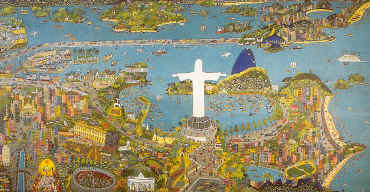

Destinations
Experiences
 |
L A
D A T C O T O U R
S |
 |
||||||||
| HOME | South America | Falkland Islands | Antarctica | Unique Destinations |
Unique Experiences |
Newsstand | ||||
 |
Rio de Janeiro Cultural Stuff |
The "almost cultural":
Sunday's Hippi Market in Leblon - varied collection of Brazilian handicrafts and art works
Carmen Miranda Museum with eclectic collection of memorabilia and paraphanelia
For the real cultural stuff:
Selected museums and cultural places of interest, taken from RIOTUR's "Rio. Incomparable. Museums and Cultural Centers":
MODERN ART MUSEUM (Tue-Sun Noon-6PM)
Created in 1948, the museum holds nearly 4,000 works that belonged to Gilberto
Chateaubriand and which were part of the most important collection of modern Brazilian
art. The MAM also has 2,000 works by national and foreign artists such as Picasso, Andy
Warhol and Le Corbusier, among others. It also has a library specialized in arts and
cinematheque with an impressive collection of films. Its building, an example of modern
architecture, was constructed in apparent concrete, in horizontal lines with an open
structure, which allows a continuity to the sea. The gardens designed by Burle Marx
integrate the building with the surrounding landscape, highlighting the flower beds full
of round pebbles and garden paths with imperial palm trees.
EDISON CARNEIRO'S FOLKLORE MUSEUM (Tue-Fri 11AM-6PM; Sat
& Sun 3PM-6PM)
In a 1,500 square meters area, approximately 12,000 pieces are on exhibition, collected
from field research, with vast photographic documentation, sound recordings, and records
of testimonies, forming sets that illustrate the most diverse aspects of cultural and
popular manifestations, with rites, festivals, dances and technologies of crafts
production.
CASA DO PONTAL MUSEUM (Daily 9AM-5PM)
The Casa do Pontal is a Brazilian popular art museum with a collection of 3,500 pieces on
exposition. It represents works by more than 200 artists form the north to the south of
the county, collected in the last fifty years by the museum founder, the French designer
Jacques van de Beuque.
CHACARA DO CEU MUSEUM (Wed-Mon Noon-5PM)
Raymundo Ottoni de Castro Maya (1894-1968), a successful businessman, dedicated himself to
the cultural life of the city as a patron of the arts, collector, and defender of cultural
and natural patrimony. He inherited the Chacara do Ceu in 1936. The present-day
construction was designed in 1957 by the modernist architect Wladimir Alves de Souza. The
Chacara do Ceu reunited important works from the European culture between the 40's and the
60's. It also has a permanent exposition, a collection o Brasiliana, in addition to an
important set of works by Candido Portinari, today considered to the the largest public
collection of this artist.
INDIAN MUSEUM (Tue-Fri 10AM-5PM & 1PM-5PM; Sat &
Sun 9AM-1PM) (Guided tours with previous reservation)
A beautiful construction of 1880, an architectonic example of the residences at the
beginning of the urbanization of the Botafogo neighborhood, it holds one of the most
important collections of the indigenous peoples of Latin America. With forty years of
tradition as a scientific-cultural organ of the National Indian Foundation, the Museum has
14,000 objects, 550,000 textual documents and 16,000 national and foreign works on
indigenous etymology and related areas, 50,000 images, 28 films, 61 videos, 41 records and
48 sound tapes. In the garden of the museum, the Guarani Indians from Bracui constructed a
house made of wooden stakes and clay, with thatched cover, sape grass, and straw. They
planted a garden around he house with medicinal herbs, corn, manioc, peanuts and beans.
All these elements together will give the visitor an idea of how the tribes live in their
villages.
NATIONAL FINE ARTS MUSEUM (Tue-Fri 10AM-6PM; Sat & Sun
2PM-6PM)
The National Fine Arts Museum has been installed since its creation in 1937 in he old
National School of Fine Arts building. The building in neoclassical style is one of
the trademarks of the opening of Avenida Central, the city's present day Rio Branco. Its
galleries hold Brazilian works from the 18th to the 20th century, as well as woks by
foreign artists, including paintings, sculptures, and illustrations. The museum also has a
collection of popular art that attests to the various regional aspects of the country, a
statue collection, African art, furniture and rooms with temporary exhibitions.